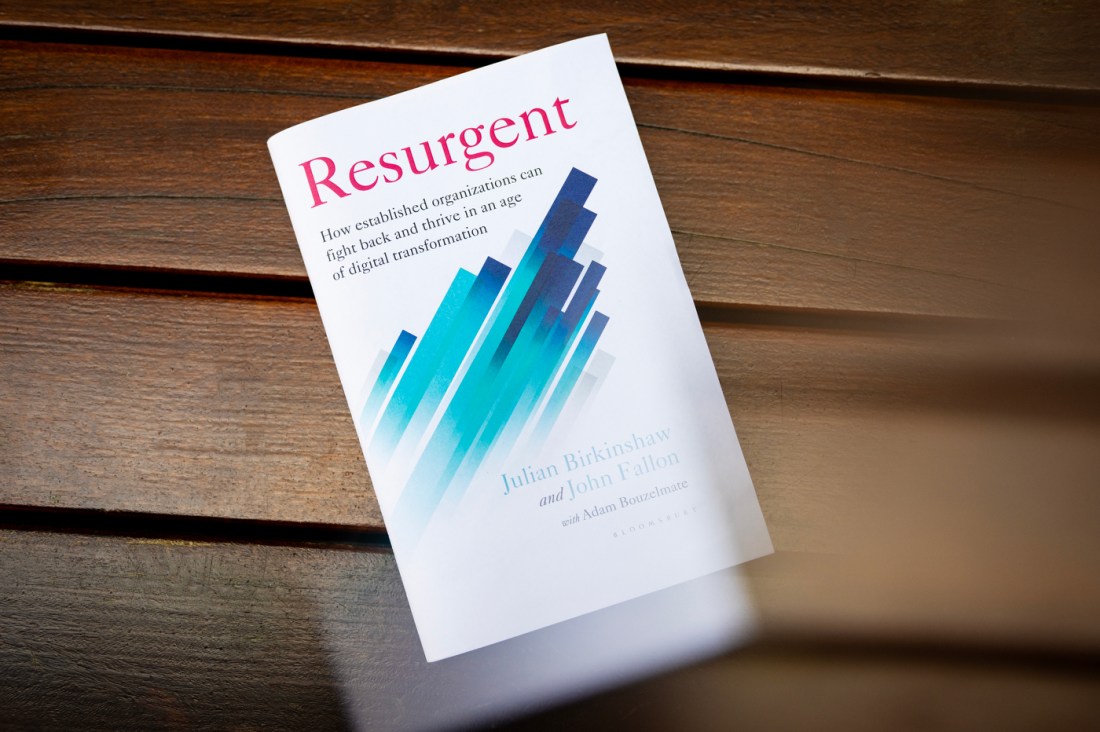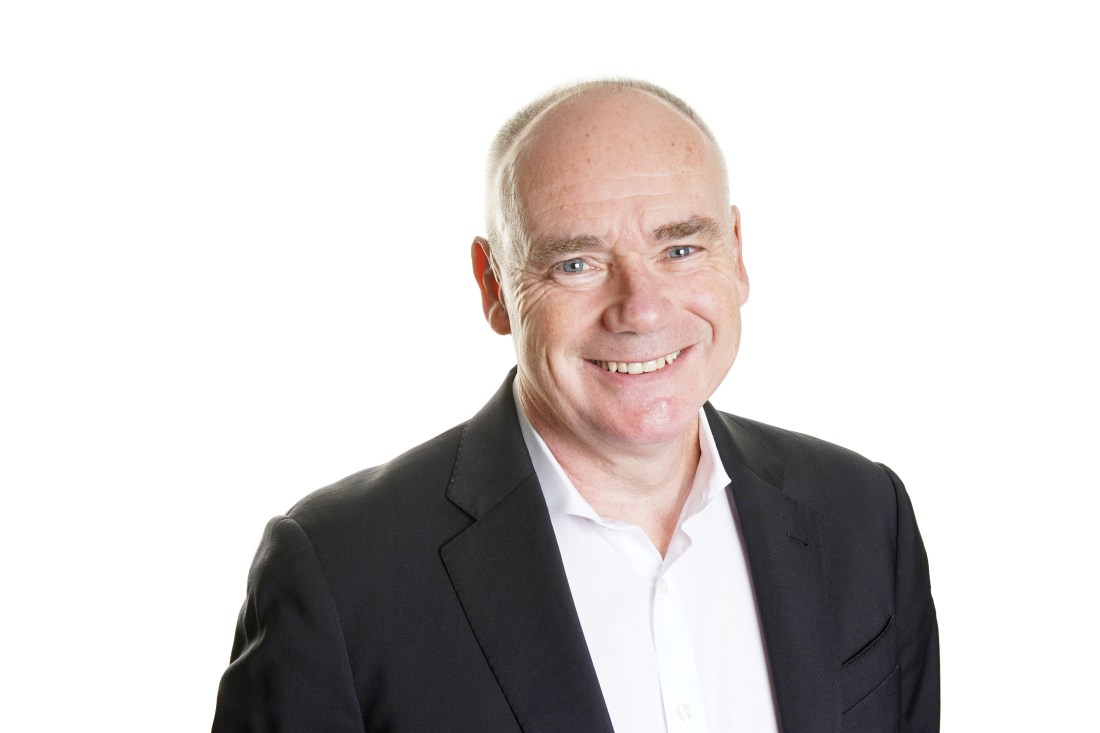Northeastern professor John Fallon, former CEO of education giant Pearson, outlines how global corporations can compete in the AI era in his new book, “Resurgent.”
![]()
 John Fallon says his book ‘Resurgent’ is designed to challenge the argument that big corporations will be made obsolete by Big Tech and other rivals. Photo by Alyssa Stone/Northeastern University
John Fallon says his book ‘Resurgent’ is designed to challenge the argument that big corporations will be made obsolete by Big Tech and other rivals. Photo by Alyssa Stone/Northeastern University
LONDON — Global corporations have the know-how and staying power to compete in the artificial intelligence age against the tech giants and startup challengers, according to a former chief executive.
John Fallon, professor of practice at Northeastern University, led Pearson plc from 2012 until his retirement in 2020, overseeing a period of major transformation for the listed U.K.-based company.
In his co-written book, “Resurgent: How established organizations can fight back and thrive in an age of digital transformation,” Fallon offers a playbook for executives steering their organizations through digital upheaval.
“The idea of the book,” says Fallon, “is that anyone who is a manager or a leader in a large company or a large organization that’s going through a major digital transformation could pick the book up and find some very practical ideas and suggestions that would help them do their job differently on Monday morning.”
Pearson, Fallon explains, was in the final stages of a massive strategy shift when he took over. It had gone from being an old-fashioned conglomerate with a diverse portfolio — owning everything from waxworks attraction Madame Tussauds to the “Baywatch”-producing entertainment company All American Television — to streamlining into one of the world’s leading education providers.
Fallon says that what he held on to when leading Pearson through a “very challenging” period in its 180-year history was his belief that large corporations could be agile enough to take on the disrupters.
“It was analog to digital and it was a big change in the business model as well, from an ownership to a subscription model,” the British businessman remembers.
“And what you find in those circumstances is the analog profits decline much more quickly than the digital revenues grow. It was a pretty bruising and difficult period, but I was always confident that Pearson would be resurgent. That after a period of decline, it would emerge stronger and recover.”
 John Fallon led Pearson for eight years before retiring in 2020 and later joining Northeastern as a professor of practice. Courtesy photo
John Fallon led Pearson for eight years before retiring in 2020 and later joining Northeastern as a professor of practice. Courtesy photo
Co-written with Julian Birkinshaw of Ivey Business School, “Resurgent” challenges the notion that only Big Tech and billion-dollar startups will lead the AI revolution.
“There is this idea,” Fallon adds, “that the companies that have been around for a long time had no future, and that we were all going to go the way of Kodak or BlackBerry — that this will be our ‘Kodak moment.’
“And instinctively my experience was that that’s not true. Digital transformation is very hard for large, established companies, but if you can combine the enduring things that made you a successful company in the first place, with learning to be much more agile, much more innovative, to reinvent yourself for the digital age, then you could emerge resurgent, you could be successful.”
“Resurgent” sets out how large companies have traditionally been far more successful in managing digital transformation than analysts have given them credit for. Through the dot-com boom of the late ’90s and the move to mobile phones from 2007 onwards, big companies have proven themselves to have staying power, Fallon argues.
“While AI is a massively disruptive technology,” he continues, “in many ways, large organizations can learn from how they’ve adapted to previous waves.”
The authors note that, as of the end of 2024, 476 of the Fortune 500 companies were founded before 1995 — long before the internet revolution began.
The pair highlight Disney as a case study. Faced with the rise of streaming platforms like YouTube, Netflix and Amazon Video, Disney responded by ramping up content production — acquiring Pixar, Marvel and Lucasfilm to secure blockbuster franchises like Star Wars. These moves gave the company leverage over streamers and paved the way for the launch of its own platform, Disney+.
Pearson conducted its own major transformation in order to secure its position, Fallon recalls. The firm made a “big bet” at the turn of the century, he says, on the future of the knowledge economy and the way the internet would radically alter how people learn.
The London-headquartered outfit was in a good place to capitalize, being the world’s largest textbook supplier. The company moved from selling high-cost textbooks to offering digital courseware that could be sold at a lower price and offer a more personalized experience for students.
Fallon notes that the streamlining process was complex, requiring Pearson to abandon legacy revenue streams and divest significant assets in order to become more agile.
During his eight-year tenure, Pearson sold the Financial Times newspaper, the publisher Penguin Random House and its stake in The Economist, raising £3 billion ($3.9 billion) in the process. Those moves were about setting the company up for the future and to minimize risk in the face of digital disruption, he says.
“When I became CEO of Pearson in 2012,” he says, “the company was still selling 20 million college textbooks in America a year. Last year it sold less than a million.
“My view was that we couldn’t ride three horses and expect to win three races, so we had to choose. If you look at what had happened in the music industry and you look at what happened in newspapers, a lot of companies didn’t survive.
“There was a real concern. People could see that those 20 million textbooks that we were selling every year in America were going into decline. It was a question of how do you make sure that you survive the other end.”
More than £1 billion ($1.3 billion) from the sales was invested into the digital transformation of Pearson, something Fallon argues put it on a stable footing.
“By selling those businesses and focusing on education, we could invest,” he says.
“We were operating on one global technology platform that was much more agile, much more mobile. It meant we reduced the cost of creating new products in half. We could be profitable at much lower price points than we could previously.
“And it meant our shareholders could be confident that however hard the transformation was, they would still own it at the end of the process and that the company would grow the other side, which is what is now happening.”
University News
Recent Stories
*{margin-block-start:0;margin-block-end:0;}.wp-container-core-group-is-layout-0f4c6871 > * + *{margin-block-start:var(–wp–preset–spacing–40);margin-block-end:0;}.wp-container-core-group-is-layout-aaffb961 > :where(:not(.alignleft):not(.alignright):not(.alignfull)){max-width:832px;margin-left:auto !important;margin-right:auto !important;}.wp-container-core-group-is-layout-aaffb961 > .alignwide{max-width:832px;}.wp-container-core-group-is-layout-aaffb961 .alignfull{max-width:none;}.wp-container-core-post-content-is-layout-575ec271 > :where(:not(.alignleft):not(.alignright):not(.alignfull)){margin-left:auto !important;margin-right:auto !important;}.wp-container-core-post-content-is-layout-575ec271 .alignfull{max-width:none;}
]]>

